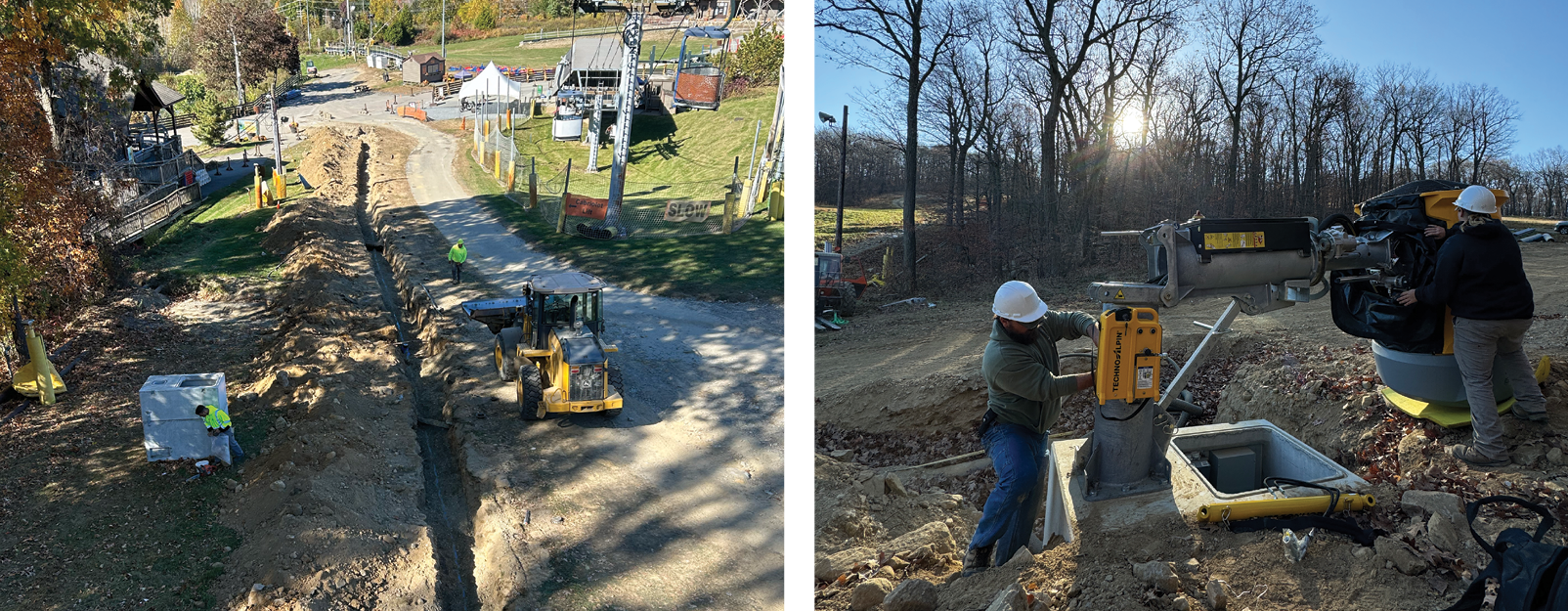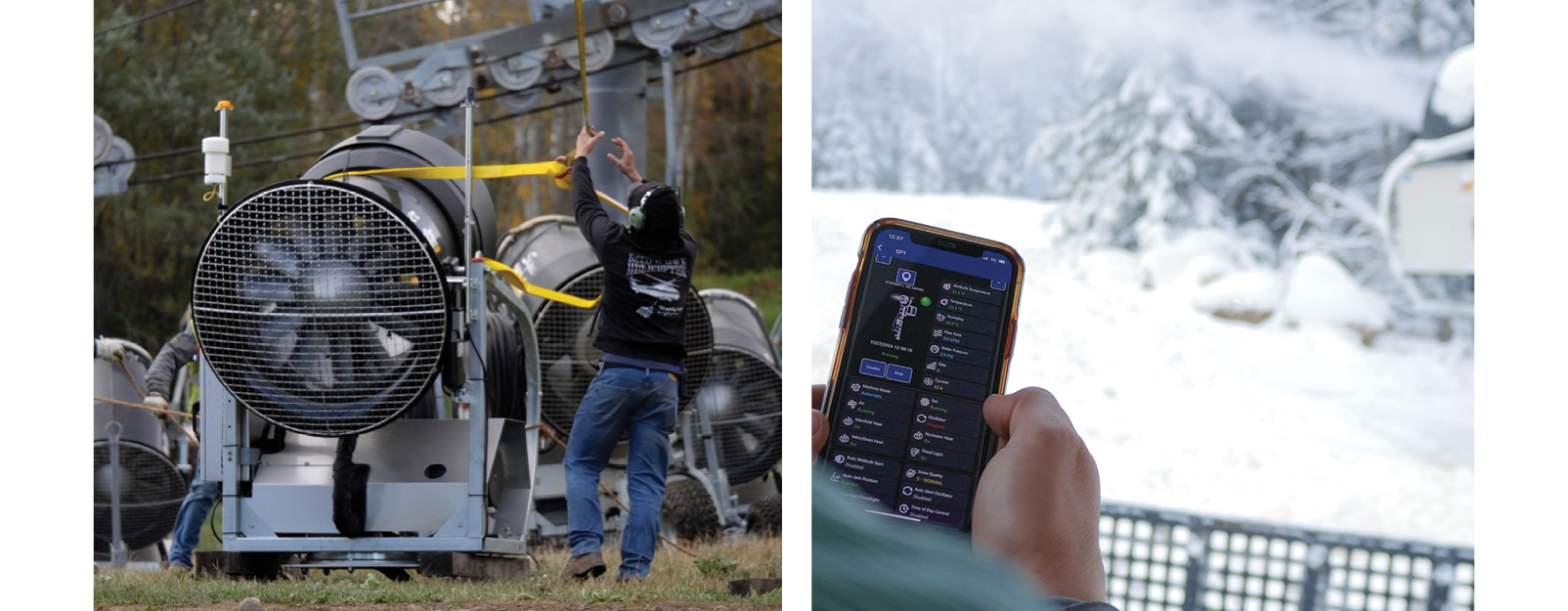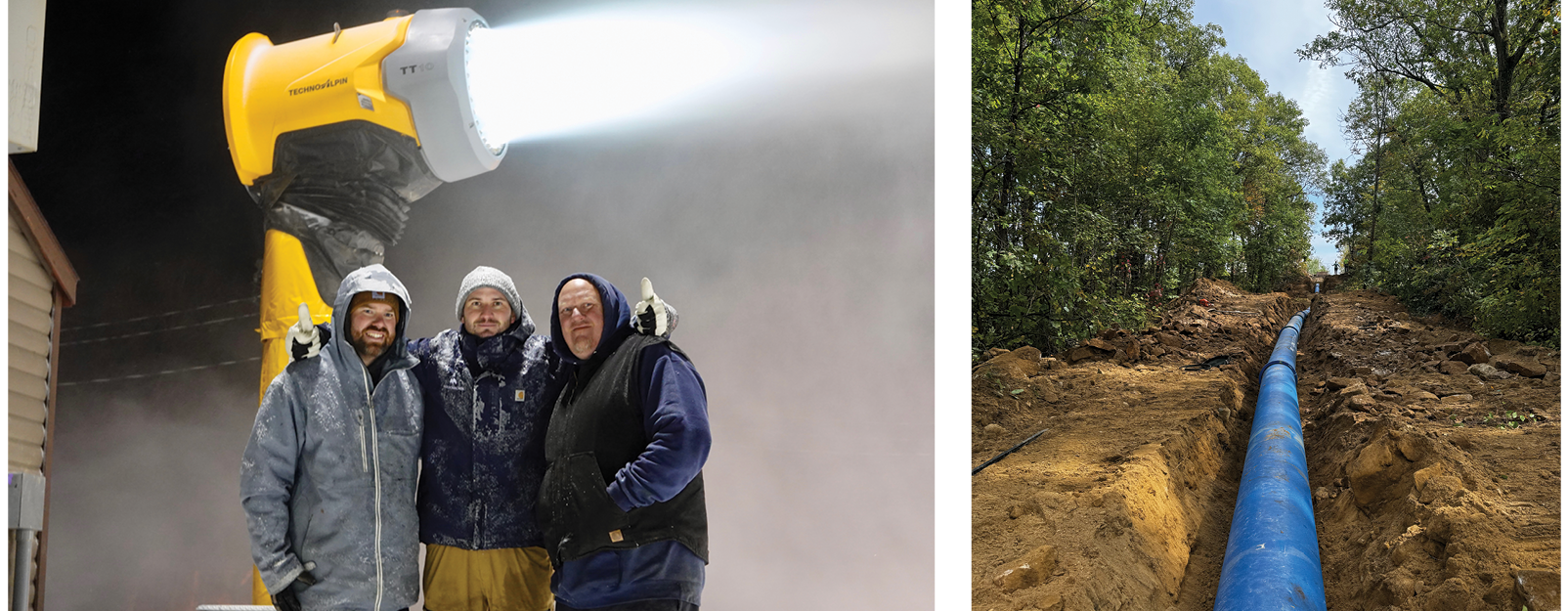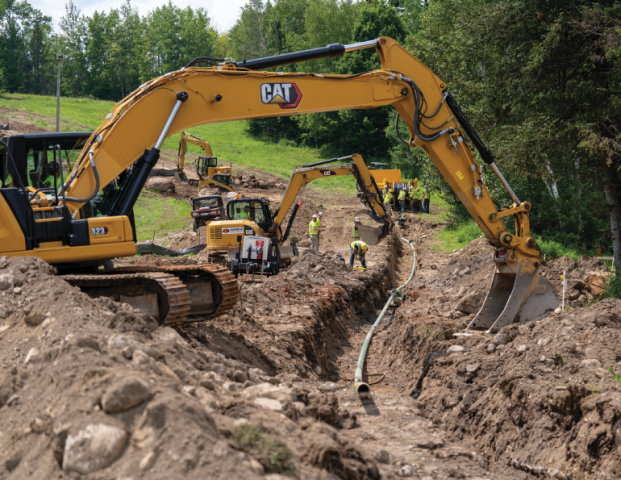In response to increasingly fickle snowmaking windows and rising energy and labor costs, Mountain Creek, N.J., and Giants Ridge, Minn., invested heavily to introduce automation to their snowmaking systems ahead of the 2024-25 season. Replacing manual equipment with automated is no small undertaking, whether it’s a single trail or a large portion of a ski area’s system. And the switch to automation changes various portions of snowmaking operations.
Was the effort, and the price tag, worth it for these two ski areas? Can old dogs be taught new tricks? Do guests notice a difference in the product or in when the terrain is able to open? In some ways, the answers to these questions now lie in the simple push of a button.
Trusting the Math at Mountain Creek
Facing shrinking snowmaking opportunities in the Mid-Atlantic, the team at Mountain Creek decided to invest $5 million in an automated snowmaking system from TechnoAlpin. The new system, which debuted in 2024-25, covers an important top-to-bottom run, all the resort’s learning terrain (four trails in total), and some key trail connectors.
The ski area replaced a mixed system of 13 fan guns and 99 air/water guns with 40 TechnoAlpin TT10 and TT9 fan guns, cutting the on-hill hardware by more than half while producing twice as much snow. The move also enabled Mountain Creek to repurpose 13 SMI PoleCats to other trails as needed, while scrapping or donating the rest of the old equipment.
To feed the new fan guns, the resort replaced the above-ground piping with below-grade ductile iron piping that allows the lines to stay fully charged and ready to go at a moment’s notice. This move alone saved the resort countless hours of charging and draining lines, which used to turn a critical five-hour snowmaking window into one that was only productive for an hour or two.
With the readiness piece of the puzzle greatly improved, the TechnoAlpin science is able to take over to calculate the snowmaking on the trails for optimal coverage.
“Although it may be uncomfortable,” says Mountain Creek general manager Evan Kovach, “my advice for anyone else working on a conversion to automated snowmaking is to trust the math. With automation, everything changes. Our start-up time moved from hours to seconds. Quite literally, with the tap or click of a screen, we can begin production and, similarly, the system knows when to shut off in the event weather shifts on us.”
The system uses real-time weather data to continuously adjust each of the 40 guns, which has had “dramatic impacts on production and quality of snow,” he says. “The difference in output between our old, manual equipment and modern equipment is very real.”
Kovach points out that the underground pipe and hydrants hidden in vaults have another, perhaps less publicized benefit compared to the previous setup. “The difference in appearance between the two systems may be the most underrated impact of the project from my perspective,” he says. “The elegance of having the infrastructure hidden below grade really changes the guest experience.”
 Left to right: Digging trenches for new water lines at Mountain Creek; installing a TechnoAlpin fan guns.
Left to right: Digging trenches for new water lines at Mountain Creek; installing a TechnoAlpin fan guns.
A Major Overhaul at Giants Ridge
Giants Ridge in the Midwest faces the same hurdles as Mountain Creek—challenging weather and small snowmaking windows. To provide more consistent and earlier coverage, the ski area invested $14 million in an SMI automated system that covers 62 percent of its terrain.
“With the old system, it took about two hours and four to six employees to get the pumps going and charge the lines. Once the lines were charged, it would take up to two shifts (16 hours) to get all the guns running,” says general manager Fred Seymour.
The old snowmaking system was a mixed fleet of 47 guns, including a dozen homemade water sticks, as well as 122 hydrants.
The new system includes 74 automated SMI fan guns (PoleCats and Super PoleCats), 68 of which are mounted on SMI Access towers, four on SMI Swing-Arm towers, and two on SMI Omni towers. Giants Ridge added another 36 manually operated SMI PoleCats, too, all of which are carriage mounted.
At the heart of the new, automated snowmaking system are 147 above ground hydrants, each with its own electrical pedestal installed as part of a complete redo of the on-hill electrical system. All wiring and two switchgears were replaced, and the ski area added two new switchgears as well to accommodate the increased demand.
While Giants Ridge didn’t make any changes to its pumphouse, it built a new valve house with an all-new manifold and electrical distribution center. The area also upgraded its piping and laid 36,000 feet of epoxy-coated pipe, both above and below ground, to feed the new (and some of the existing) system.
With the new automated system, “Starting the guns can be done with the click of a mouse or by using the Smart Snow app on a phone,” says Seymour. “One person can start 74 automated towers in 5-10 minutes,” and Giants Ridge can run two pumps when filling the lines, which “cuts the charging time in half.”
Another advantage: “Being able to come back and refresh runs without setting machines back up, hauling hoses, and closing runs allows us to consistently provide a great product for the guest,” he says.
 Left to right: A Giants Ridge employee hooks up a new SMI fan gun for helicopter transport; A mobile app allows Giants Ridge snowmakers to remotely control the new automated system
Left to right: A Giants Ridge employee hooks up a new SMI fan gun for helicopter transport; A mobile app allows Giants Ridge snowmakers to remotely control the new automated system
Real Savings
The primary objective of an automated snowmaking upgrade is to take advantage of every snowmaking minute, but cost savings are a close second and welcome byproduct.
“Our savings are in labor, fuel, and energy,” says Seymour. Giants Ridge cut total snowmaking hours from 751 to 532 this past season, leading to $200,000 in electricity savings. The ski area also saved on fuel by using fewer snowcat hours to move equipment around the mountain.
While Giants Ridge hired the same number of snowmakers, the reduced snowmaking hours allowed it to transition snowmaking employees to lift ops earlier in the season. (The ski area makes all its snow in the early season before the Christmas holiday.)
Mountain Creek also hired the same number of snowmaking staff year-over-year and still realized considerable savings. “We’ve seen a 70 percent savings in energy consumption/cost where we’ve upgraded to automated snowmaking,” says Kovach, “and that’s with producing more than two times the output we typically would with the old system.”
A single old air/water gun used as much energy as six of the new TechnoAlpin fan guns, he says, meaning Mountain Creek now runs 15 percent of its new system for the same cost it once took to operate just 1 percent of the old one.
The ski area is also able to “dance around demand charges more nimbly with the quicker start-ups and shut downs that automation brings,” which translates to further energy cost savings.
Old Dogs, New Tricks
Both GMs agreed the transition from manual snowmaking to an automated system was relatively easy. “The learning curve with using the new system was more of a straight line,” says Kovach. “The app is very easy to use and there weren’t any surprises once we got up and running. There were a few moments of, ‘Oh wow, it really is that easy.’”
At Mountain Creek, TechnoAlpin sent techs to conduct a full day of orientation training that included snowmakers, management personnel (Kovach among them), and a few cat operators who work in the areas that were upgraded.
At Giants Ridge, where most snowmakers are seasonal employees who work in other departments, training focused on management and IT. “There was a lot to learn with the automation piece,” says Seymour, “but SMI were great partners all through the project and were available on site for help.”
 Left to right: Tim Stone, Evan Kovach (center), and Mathew Carter celebrate the new automated system at Mountain Creek; ductile iron piping goes into the ground at Mountain Creek.
Left to right: Tim Stone, Evan Kovach (center), and Mathew Carter celebrate the new automated system at Mountain Creek; ductile iron piping goes into the ground at Mountain Creek.
Fine-Tune It
Automation doesn’t remove the human component from snowmaking. While the systems are designed to optimize production on their own, Mountain Creek’s team is still able to fine-tune things based on conditions, visitor traffic, and other ops considerations.
Kovach says the resort’s TechnoAlpin system can be programmed to perform specific commands such as:
Make two inches of snow on a trail on a particular night and then turn off.
Adjust snowmaking according to skier traffic.
Consume one million gallons of water and then turn off.
Make snow from 10 p.m. to 2 a.m. and then turn off.
Make heavy, wet, base snow from 5 p.m. to 2 a.m. and then switch to dry/light snow from 2 a.m. to 8 a.m.
Oscillate guns 50 degrees after 5 a.m.
Additionally, Mountain Creek’s snow groomers are armed with tablets that allow them to make real-time tweaks to the snowmaking while they are out pushing snow on the hill.
Satisfied Customers
Both Mountain Creek and Giants Ridge agree automated snowmaking has led to an increase in customer satisfaction and confidence.
At Giants Ridge, Seymour says, the goal is always to be open on Thanksgiving weekend with good coverage. “The two years prior to the snowmaking system upgrade, that was not possible,” he says. With the new system, “we only missed it by one day this year”—the Nov. 30 opening delighted guests.
Guest feedback at Mountain Creek has also been enthusiastic. “A quick scroll of our social channels shows that, outside of opening earlier for our guests, they are hugely impressed with the snow quality on the trails where we have added automation,” says Kovach.
Both ski areas saw an increase in skier visits throughout the season, and Mountain Creek even credits an increase in early pass sales for 2025-26 to the new automated snowmaking system.
With positive results, do the resorts plan to add more automated snowmaking in the future?
After such a massive investment to convert most of its snowmaking to automation, Seymour says Giants Ridge may look to install additional tower-mounted machines down the road “as the budget allows.”
Mountain Creek is already making moves to add more. “This was our first major venture into the world of automated snowmaking, and we’re sold on it,” says Kovach. “We credit our early opening to this investment, and we’re currently in the process of planning our next phase of automation.”
While technology and automation can’t solve every snowmaking challenge, the investment so far for these two ski areas has been worthwhile.





